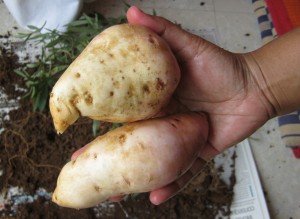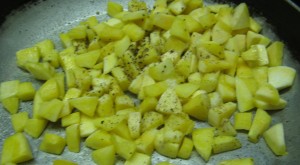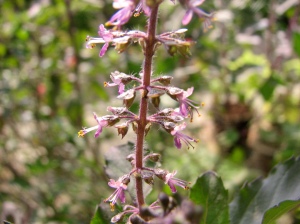A couple of years back I shifted to a flat. We did not have a single plant in our house. So we brought a couple of pots in which to put some plants. We started with “money plant” but it seemed it did notlike growing in our window. We tried many other things but none survived. All of them would die, perhaps due to lack of sunlight or some infestation.
It so turned out that the sweet potato is not that sweet after all. It has a low GI (glycemic index). Some of the sweet potatoes that we had brought, and kept in the corner developed some really cool purple coloured shoots. We then thought of planting these and see. And grow they did. The shoots grew at an astounding rate, as if they were on some sort of steroids. Withinn a week they scaled the height of the window (~ 5 ft.). We had to manage them horizontally afterwards. But this was it, the plants became very dense and we planted some more. So we had a nice vine over the window. We never bothered to see if they
had grown any roots that we could eat. It was more used like an ornamental plant.
When we shifted to our current home we brought the pot with us. For travel, we had cut all the branches and left the root intact. But after coming the new house, where we had access to the sunlight. The plant did not grow, it died. That is when we planted some new shoots in the pot, two of them. And then forgot about them. We water them daily but, it was in a rather inaccessible corner of the balcony so, we could not look at it properly.
It so happened one day I noticed something strange. Something (most probably a bird) had dug out the soil in that pot and uncovered what was unmistakably surface of a sweet potato. There were beak like marks on the surface. It was like a treasure was exposed. I promptly covered the exposed area with extra soil. It was then that I noticed that the plant had grown a lot but since its branches were hanging low and at an angle than hid it from us, we had not seen them.
So, this is the background. Yesterday, being a Sunday we decided to take out the potatoes out. So what follows is a picture essay of uncovering the harvest of the sweet potatoes.
The Plant with its leaves.

Put a paper on the floor to collect the soil.

Start the digging. Felt like a forager!

First sweet glimpse!

And they are out!

With the roots removed.

Washed!

Portrait shot No. 1

Portrait Shot No. 2

Nicely cut and washed!

Removing the extra water.

In the fry pan!

And with salt and pepper!

That’s it for now folks!
plants
Radical Openness – Scientific Research
“The more we’re getting into this the more it’s apparent this is a radical new way to scientific research. Traditional research is done in an institution with patent protection. IP protection and patents slows progress because it reduces collaboration and makes it harder to build on the work of others. Our project, we don’t have a central body. It’s the public, they’re the ones who get excited. Because we’re not beholden to shareholders we can create a community.”
via Glowing Plant| Singularity Hub.
I just hope that this project is successful and will create a new way of doing scientific research which will involve common people.
Does Tulsi has environmental benefits too?

Recently there was a news item in Times of India which had the same heading as that of this particular post. The news claimed
(Around two decades back Dada Dham, a socio-spiritual organization brought together a team of botanists, ayurvedic scholars and environmental enthusiasts to study the environmental benefits of tulsi.)NAGPUR: Ayurvedic medicinal values of Tulsi are well known. Our ancient scriptures have enumerated the medicinal benefits of tulsi. Its extracts are used widely for curing common ailments like common cold, headache, stomach disorder etc.
But the environmental benefits have been comparatively unknown. Around two decades back Dada Dham, a socio-spiritual organization brought together a team of botanists, ayurvedic scholars and environmental enthusiasts to study the environmental benefits of tulsi.
“Tulsi gives out oxygen for 20 hours and ozone for four hours a day along with the formation of nascent oxygen which absorbs harmful gases like carbon monoxide, carbon dioxide and sulphur dioxide from the environment,” said Shyamkant Padoley, an eminent botanist.
Ozone is a powerful oxidant (far more so than dioxygen) and has many industrial and consumer applications related to oxidation. This same high oxidizing potential, however, causes ozone to damage mucus and respiratory tissues in animals, and also tissues in plants, above concentrations of about 100 parts per billion. This makes ozone a potent respiratory hazard and pollutant near ground level.…There is evidence of significant reduction in agricultural yields because of increased ground-level ozone and pollution which interferes with photosynthesis and stunts overall growth of some plant species. The United States Environmental Protection Agency is proposing a secondary regulation to reduce crop damage, in addition to the primary regulation designed for the protection of human health.…There is a great deal of evidence to show that ground level ozone can harm lung function and irritate the respiratory system.Exposure to ozone and the pollutants that produce it is linked to premature death, asthma, bronchitis, heart attack, and other cardiopulmonary problems.…
Padoley, member of technical committee, ministry of environment and forest, NewDelhi, and forest tech committee, also read a paper at the International Conference on Occupational Respiratory Diseases at Kyoto in 1997 where cyclo oxygenate, an enzyme only found in tulsi was labelled for the first time. This enzyme regulates the entire mechanism of oxygen evolution. (emphasis added)
This again I am unable to understand. It says this enzyme is “only found in Tulsi”, and it also “regulates entire mechanism of oxygen evolution”. One can agree that a particular enzyme is found in a particular plant, but if this enzyme controls “entire mechanism of oxygen evolution”, how do other plants regulate their mechanisms of oxygen evolution.
Dada Dham initiated a campaign ‘Tulsi Lagao Pradushan Hatao’ in 1987 under the guidance of Narendra Dada, the institution’s head. It was under this campaign that the above mentioned panel of experts was formed. After finding out the environmental benefits of the plant, Dada Dham organized a number of programmes like street plays, nukkad sabhas and lectures to propagate the use of the plant.
Dr Dattatraya Saraf, an ayurvedic doctor and expert said, “The plant enriches the environment with oxygen almost 24X7 and also absorbs other pollutants.” He further added that if the size of the plant can be increased, the environmental benefits can be increased.
This statement that “plant enriches the environment with oxygen almost 24X7” is in contradiction to statement by above Padoley regarding 20 and 4 hour cycles. Which one is to be believed? And mind you this is just appearing a few lines later, this is either very poor editing and reporting, or hogwash to the public.
“That is why we want to urge scientists and concerned authorities to make research on the issue of increasing the height of tulsi plant. If big trees can be converted to bonsai plants then big tulsi trees can be possible too,” said Kishor Verma, PRO of Dada Dham.
This is another statement that I would like to contest. Did they compare the rate of oxygen production vis-a-vis to other plants. That is to say simply did they have any control sample? And does making “tulsi tree” make any sense (can one really do it is another question), will it really increase oxygen making capabilities, is it a linear relationship between these two variables? The water is completely muddy in this !
He also citied the research and work by other organization in support of tulsi’s environmental benefits.
“The forest department of Uttar Pradesh, with the help of an organization called Organic India Limited, Lucknow planted lakhs of tulsi saplings around Taj Mahal to protect its surface from industrial emissions. This step has yielded positive results,” Verma said.
“We are just asking the administration to take notice of these extra ordinary benefits of tulsi and take steps for utilizing them. Even simple steps like planting tulsi plants on road dividers, parks etc can bring a difference,” said Verma.
The reporter and also the editor make no effort to correct these glaring inconsistencies in the report itself, forget about doing nay research on the topic, or verifying the claims made by these people. Maybe this was like the paid news that is talked about a lot these days.
What I find here i that the agenda of what is to be done was already set, the conclusions were already drawn, by our ancestors, written in black and white in ancient texts. The point was only to justify what they were doing, and trying to provide a “scientific basis” of what they already believed to be true (for whatever reasons, mostly religious, and presence of a religious organization in this sort of confirms this).
A good example of pseudo-science and bad science reporting.
Orchids

Orchids have the most beautiful flowers in the world. If you don’t agree with me, just have a look below. Though in the wild I have been able to spot them only twice. I went to a flower show where I could get an actual glimpse of their beauty.
So here they are…
Some [most] classifications are pending, they will be done when Ritesh finds time….

















